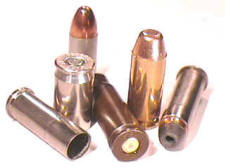Cartridge Case Identification
Like
bullets, cartridge cases can be identified as having been fired by a
specific firearm. As soon as cartridges are loaded into a
firearm the potential for the transfer of unique tool marks
exists. However, the cartridge does not have to be fired for these marks
to be transferred. Simply loading a cartridge into a
firearm can cause unique identifiable marks that can be
later identified.
 Cartridge
cases like those on the right are mostly made of brass but can also be
made of other materials such as steel and plastic. Cartridge
cases come in a variety of finishes but all are made of a material
that is softer than the materials found in a firearm. Any surface of the cartridge case that meets the inner workings of the
firearm may be marked. Cartridge
cases like those on the right are mostly made of brass but can also be
made of other materials such as steel and plastic. Cartridge
cases come in a variety of finishes but all are made of a material
that is softer than the materials found in a firearm. Any surface of the cartridge case that meets the inner workings of the
firearm may be marked.
Tool
marks produced on the cartridge cases will be in two basic
forms. As the microscopic striations found on bullets,
cartridge cases can pick up striated
action marks. These
"scratches" are produced when the cartridge case moves laterally against the
tool (inner surface of the firearm) producing a scrape or striated
mark. The other form of marks that can be left on a cartridge
case are impressed action marks. Impressed
marks are created on cartridge cases when it impacts the tool (again, the firearm)
with adequate velocity or pressure to leave an impressed or indented mark.
Cartridge
cases are compared to fired standards from a firearm using a
comparison microscope as described on the bullet
identification page. Standards are first
examined to determine what marks, if any, the firearm is consistently
reproducing. Evidence cartridge cases are then directly
compared to the standards to see if they too are also similarly
marked.
Cartridge
case comparison results may
be reported as follows:
Exhibit
1 (cartridge case) was identified as having been fired by Exhibit 2
(firearm).
The
above conclusion is reached if the action marks present on the
questioned cartridge case are determined to be because of the
actual firing process. An example of which can be breech marks
as seen in the comparison image below.

Exhibit
1 (cartridge case) could neither be identified nor eliminated as
having been fired by Exhibit 2 (firearm).
The
above conclusion is reached if the cartridge case lacks sufficient
action marks to be identified as having been fired by the questioned
firearm or the firearm in question fails to produce reproducible
individual characteristics on standards. All general class characteristics
such as caliber and firing pin shape would have to agree. The image below shows a comparison between two
cartridge cases that lack any individual characteristics but have a
similar general appearance.

Exhibit
1 (cartridge case) was not fired by Exhibit 2 (firearm).
This
conclusion can sometimes be reached when the submitted cartridge
case exhibits very good individual characteristics that are very dissimilar
to those produced on standards. However, consideration must be
given to the possibility that the firearm in question could have
changed significantly. If all dissimilarities can be accounted
for, a negative conclusion will be reached. The comparison
image below shows two cartridge cases that exhibit noticeably
different breech marks and firing pin impressions.

Exhibit
1 (cartridge case) was identified as having passed through the
action of Exhibit 2 (firearm).
This
conclusion can be reached if the cartridge case is found to have
action marks that result from simply loading and/or unloading a
cartridge case in a firearm. The comparison image below shows
striated action marks on the shoulder of cartridges that have been
loaded and unloaded in a Chinese AK Type assault rifle.

|